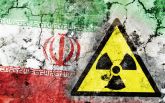×


We have detected your country as:
Please click here to go to the USA website or select another country from the dropdown list.
 Maslowski Marcin/Drop of Light/shutterstock.com What would you do with $30-$50 billion? In all likelihood, buying missiles for terrorists, sponsoring rebels to overthrow nearby governments and subsidizing a brutal dictator wouldn’t immediately come to mind. That is, unless you’re Iran. Over the next couple of years, Iran is expected to reap tens of billions of dollars via sanctions relief promised in the nuclear deal they signed with major world powers. And that’s just the initial influx of cash, not counting the longer-term economic benefits that could give Iran a boost for years to come. So while Iran will be counting dollars, the rest of the world could be counting bodies.
Maslowski Marcin/Drop of Light/shutterstock.com What would you do with $30-$50 billion? In all likelihood, buying missiles for terrorists, sponsoring rebels to overthrow nearby governments and subsidizing a brutal dictator wouldn’t immediately come to mind. That is, unless you’re Iran. Over the next couple of years, Iran is expected to reap tens of billions of dollars via sanctions relief promised in the nuclear deal they signed with major world powers. And that’s just the initial influx of cash, not counting the longer-term economic benefits that could give Iran a boost for years to come. So while Iran will be counting dollars, the rest of the world could be counting bodies.
The amount of the initial flood of money bound for Iran is up for debate. While Iran could reap $100 billion in frozen monies that will be freed up in the deal, US Treasury Secretary Jack Lew said Iran has already committed half of it, leaving them about $50 billion, according to The Fiscal Times. Economics Professor Dr. Djavad Salehi-Isfahani, non-resident senior fellow at The Brookings Institution, when interviewed by The Mideast Update estimated that guess to be at the high end.
“The exact amount is not certain, but between $30-$50 billion in released money [is] from frozen Iranian assets abroad,” he said. “This will arrive over one to two years. Another source is from increased oil sales, probably an additional $10 billion per year.” Compared to other Iranian business, he said it’s “not a huge amount.” Of course, that’s not all Iran will be acquiring. “Most of the gains will come as restrictions against trade and Iranian banks are removed,” said Dr. Salehi-Isfahani.
Tens of billions of dollars for an aggressive nation to spend on its nasty friends sounds frightening. But don’t forget that Iran has its own problems at home to spend on as well. The Iranian economy lost 5.6% of its national income, or Gross Domestic Product (GDP), in 2012–13, according to Dr. Salehi-Isfahani. “It is stagnating,” he said of Iran’s economy. “…and has a huge unemployment problem.”
On the one hand, that situation is reassuring—Iran has plenty of domestic concerns on which to spend their new-found money. But then one remembers what they’ve been able to do in spite of their economic problems over the last few years. That’s when the worries come back.
Syria, Lebanon, Gaza, Iraq, Yemen and possibly Bahrain and Kuwait. No, it’s not a Middle East geography lesson, that’s a list of all the places where Iran has been meddling, and it’s not even a complete list. Furthermore, that meddling happened when things were bad economically. Dr. Jonathan Spyer, a Middle East expert and senior research fellow with the Global Research in International Affairs (GLORIA) Center in Israel, told The Mideast Update that Iran is believed to have spent tens of billions of dollars on sponsoring proxies, terrorists, rebels and dictators in the above countries.
 MyImages-Micha/shutterstock.com “Even when they were under genuine and crippling sanctions and people were suffering, they still managed to find the billions of dollars necessary to maintain the current level of commitment,” said Dr. Spyer. “There’s no reason to believe they won’t be able to do a similar thing, just on a much larger scale when there’s much more money around to play with.”
MyImages-Micha/shutterstock.com “Even when they were under genuine and crippling sanctions and people were suffering, they still managed to find the billions of dollars necessary to maintain the current level of commitment,” said Dr. Spyer. “There’s no reason to believe they won’t be able to do a similar thing, just on a much larger scale when there’s much more money around to play with.”
He noted that among the things that money can buy include training and weapons, [along with] missiles for Hezbollah that “can cover the entirety of Israel.” Then there’s the huge aid being given to keep the Syrian regime, an Iranian ally, afloat in their civil war. “The Syrian regime probably would have fallen,” without Iranian financial support and the military assistance of Iran’s proxy Hezbollah, said Dr. Spyer. The Syrian civil war, according to the United Nations, has cost hundreds of thousands of lives so far.
Dr. Spyer also said that Iran has bought influence in Iraq, with the four main Iraqi militias “either Iranian-controlled or at least supportive of Iran.” Those groups have a political presence that includes members of Iraq’s government. And don’t forget Iranian support for rebels in Yemen and Palestinian terrorists. If that sounds like a lot, it is, and sadly it may have been too much for Iran to keep going…if not for the sanctions relief. “There was a sense in which perhaps they were beginning to look a bit overstretched, but of course that’s no longer the case,” said Dr. Spyer.
Among the critics of the Iran deal include US Senator Chuck Schumer, who is a prominent member of the same political party as US President, and deal sponsor, Barack Obama. In a statement posted to his website in August, Schumer said the non-nuclear benefits of the deal, including the additional funds that could be used to bolster Iran’s military, terrorism and even build missiles able to reach the US, “gives me the most pause.”
“Restrictions should have been put in place limiting how Iran could use its new resources,” said Schumer. “…I think there is a strong case that we are better off without an agreement than with one.”
And the money for Iran may not even be the worst part of it. The lesson Iran has learned may be a greater threat. Said Dr. Spyer of the sanctions relief, “Overall, what it means is that the Iranians feel that they have received carte blanche now to continue their already existing pattern of behavior.”
In other words, expect the Iranians to keep signing checks—and more of them—in blood.
Source: By Joshua Spurlock, The Mideast Update
Photo License: Maslowski Marcin/Drop of Light/shutterstock.com
All logos and trademarks in this site are property of their respective owner. All other materials are property of Bridges for Peace. Copyright © 2024.
Website Site Design by J-Town Internet Services Ltd. - Based in Jerusalem and Serving the World.